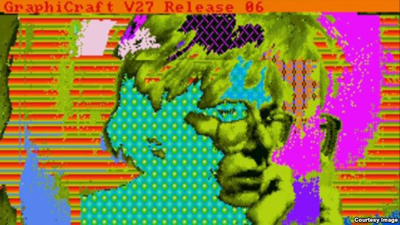VOA慢速英语:安迪·沃霍尔的数码作品重现天日
Today on the show we take a look at some recently recovered works byformer pop culture artist Andy Warhol.
Artist Andy Warhol was best-known for his paintings of actress MarilynMonroe and a large can of a Campbell’s soup. But what few peopleremember is his experimentation with a computer called the Amiga. Warhol’sart on that computer might have been lost if it was not for the work of an artand technology partnership. Marsha James reports.
Keith Bare is a computer software engineer in Pittsburgh, Pennsylvania. Entering the lower level of his house is like stepping into a computing timemachine. His big equipment and noisy disc drives have spent years collectingdust in other people’s homes.

Keith Bare belongs to the Carnegie Mellon University Computer Club. Otherclub members call him the “Amiga Guru” or expert. The Amiga was a productof Commodore International. Back in 1985, the Commodore Amiga was thelatest and greatest computer in the industry. The company got Andy Warholto demonstrate its capabilities at an Amiga launch party. The artist used itsimage-making equipment and a revolutionary device -- a digital camera.
“He took some digital pictures and modified them before most people had been thinking about digital photography at all.”
And that was all the public saw of Andy Warhol’s computer art.
The artist died in 1987. His computer and its floppy discs were put intostorage at The Andy Warhol Museum in Pittsburgh. They remained there for 25 years. That might have been the end of the story. But, then, Divya Heffleyof Carnegie Museum of Art came across a YouTube video. It shows Warholat the Amiga launch.
Ms. Heffley is producing a documentary series called “The InvisiblePhotograph.” She knew Warhol’s Amiga work should be included.
“Those drawings would have been lost.”
That idea brought the Carnegie Museum of Art together with the Andy WarholMuseum and The Carnegie Mellon University Computer Club. All threewanted to recover the information from Warhol’s Amiga computer.
The researchers were filmed as they explored the discs for the first time. Keith Bare said it took them some time just to learn how to use the software.
“Not only is it relying on the digital media surviving, another thing that we reallydon’t think about it, is you also need to be able to have software that’s able tounderstand the digital data.”
But with some recovery software engineering work, they were able to makethe discs work.
“There it is…”
“I think that…I think that that is a Warhol that nobody has ever seen before.”
The famed images of a digital Campbell’s soup can and Warhol’s picture ofhimself are just some of the 23 images recovered from the floppy discs.
Divya Heffley says the search for the stored art is both a history lesson and awarning.
“If we’re not careful technology will become obsolete, and we will no longerhave the ability to see the photographs. To see the images we hold so dearand so precious.”
The Warhol images can be seen on part two of Carnegie Museum of Art’s “The Invisible Photograph.” It is called, “Trapped: Andy Warhol’s AmigaExperiments.”
I’m Caty Weaver.
Do you have a question about American life, people or places? Send an emailto learningenglish@voanews.com. We might answer your question in a futureshow. Join us again next week for another American Mosaic from VOALearning English.
- 频道推荐
- |
- 全站推荐
- 推荐下载
- 网站推荐




















